
The Nahuas are a group of the Indigenous people of Mexico, El Salvador, Guatemala, Honduras, Nicaragua, and Costa Rica. They comprise the largest indigenous group in Mexico and El Salvador. They are a Mesoamerican ethnicity. The Mexica (Aztecs) are of Nahua ethnicity, as are their historical enemies, the Tlaxcallans (Tlaxcaltecs), and the Toltecs which predated both groups are often thought to have been as well. However, in the pre-Columbian period Nahuas were subdivided into many groups that did not necessarily share a common identity.

Nuevo Reino de Galicia or simply Nueva Galicia was an autonomous kingdom of the Viceroyalty of New Spain. It was named after Galicia in Spain. Nueva Galicia's territory consisted of the present-day Mexican states of Aguascalientes, Guanajuato, Colima, Jalisco, Nayarit and Zacatecas.
The Cuyuteco people, also known as Cuyuteca, was a tribe of the Nahua culture, that lived primarily in the Pre-Columbian Mixtlán region of Xalisco, in the present day state of Jalisco in western central Mexico and along the Colima coastline. The Nahua are one of the main cultural groups of Mesoamerica.
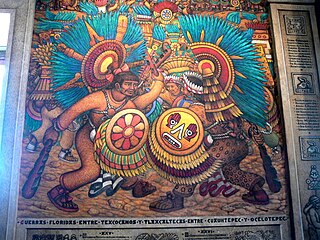
The Tlaxcallans, or Tlaxcaltecs, are an indigenous Nahua people who originate from Tlaxcala, Mexico. The Confederacy of Tlaxcala was instrumental in overthrowing the Aztec Empire in 1521, alongside conquistadors from the Kingdom of Spain. The Tlaxcallans remained allies of the Spanish for 300 years until the Independence of Mexico in 1821.

The Zacatecos is the name of an indigenous group, one of the peoples called Chichimecas by the Aztecs. They lived in most of what is now the state of Zacatecas and the northeastern part of Durango. They have many direct descendants, but most of their culture and traditions have disappeared with time. Large concentrations of modern-day descendants may reside in Zacatecas and Durango, as well as other large cities of Mexico.

The Guachichil, Cuauchichil, or Quauhchichitl, are an exonym for an Indigenous people of Mexico. Prior to European and African contact, they occupied the most extensive territory of all the Indigenous Chichimeca tribes in pre-Columbian central Mexico.

The Caxcan are an ethnic group who are Indigenous to western and north-central Mexico, particularly the regions corresponding to modern-day Zacatecas, southern Durango, Jalisco, Colima, Aguascalientes, Nayarit. The Caxcan language is most often documented as an ancient variant of Nahuatl and is a member of the Uto-Aztecan language family. The last generation of natively fluent Caxcan language speakers came to an end in the 1890s. Despite this having long been conflated by anthropologists with an extinction of the Caxcan people themselves, much of Caxcan culture has persisted via oral tradition. There is currently an ongoing revitalization of Caxcan language, scholarship, and culture.
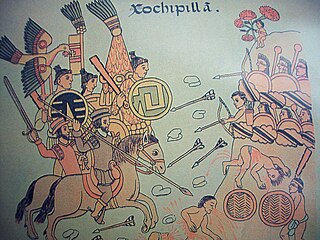
The Mixtón War (1540-1542) was a rebellion by the Caxcan people of northwestern Mexico against the Spanish conquerors. The war was named after Mixtón, a hill in Zacatecas which served as an Indigenous stronghold.
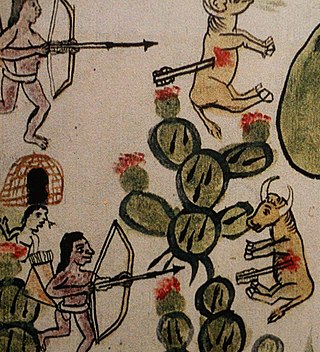
The Chichimeca War (1550–90) was a military conflict between the Spanish Empire and the Chichimeca Confederation established in the territories today known as the Central Mexican Plateau, called by the Conquistadores La Gran Chichimeca. The epicenter of the hostilities was the region now called the Bajío. The Chichimeca War is recorded as the longest and most expensive military campaign confronting the Spanish Empire and indigenous people in Aridoamerica. The forty-year conflict was settled through several peace treaties driven by the Spaniards which led to the pacification and, ultimately, the streamlined integration of the native populations into the New Spain society.

Jalostotitlán is a town and municipality located in the northeast corner of the state of Jalisco, Mexico, in a region known as Los Altos.
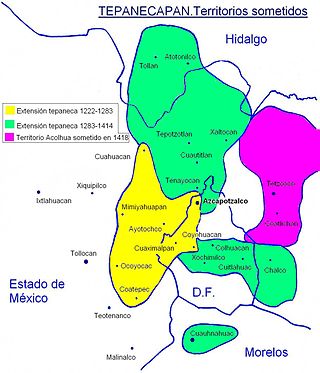
The Tepanecs or Tepaneca are a Mesoamerican people who arrived in the Valley of Mexico in the late 12th or early 13th centuries. The Tepanec were a sister culture of the Aztecs as well as the Acolhua and others—these tribes spoke the Nahuatl language and shared the same general pantheon, with local and tribal variations.

The Spanish conquest of the Aztec Empire was a pivotal event in the history of the Americas, marked by the collision of the Aztec Triple Alliance and the Spanish Empire, ultimately reshaping the course of human history. Taking place between 1519 and 1521, this event saw the Spanish conquistador Hernán Cortés, and his small army of soldiers and indigenous allies, overthrowing one of the most powerful empires in Mesoamerica.

The Mexica are a Nahuatl-speaking people of the Valley of Mexico who were the rulers of the Triple Alliance, more commonly referred to as the Aztec Empire. The Mexica established Tenochtitlan, a settlement on an island in Lake Texcoco, in 1325. A dissident group in Tenochtitlan separated and founded the settlement of Tlatelolco with its own dynastic lineage. In 1521, their empire was overthrown by an alliance of Spanish conquistadors and rival indigenous warriors, led by the Tlaxcaltec leader Xicotencatl the Elder and the Spaniard Hernán Cortés. The Mexica were subjugated under the Kingdom of Spain for 300 years, until the Mexican War of Independence in 1821.
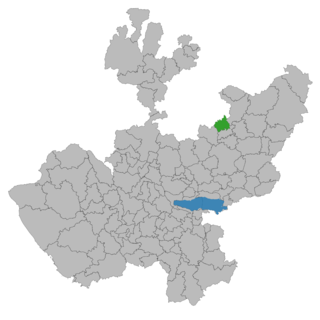
Mexticacán is a town and municipality in the Southern Zone of Los Altos Region of Jalisco. Mexticacán comes from the Nahuatl language and means "place where the temple for the worship of the moon".

Francisco Tenamaztle, also Tenamaxtlan, Tenamaxtli or Tenamaxtle, was a leader of the Caxcan Indigenous peoples in Mexico during the Mixtón War of 1540–1542. He was later put on trial in Spain. With the support of Bartolomé de las Casas he defended the justice of his cause by appealing to King Carlos I.
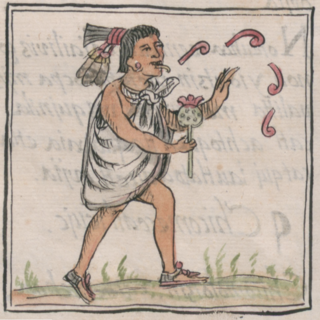
Nahuatl, Aztec, or Mexicano is a language or, by some definitions, a group of languages of the Uto-Aztecan language family. Varieties of Nahuatl are spoken by about 1.7 million Nahua peoples, most of whom live mainly in Central Mexico and have smaller populations in the United States.
El Opeño is a Mesoamerican archaeological site located in the municipality of Jacona in the state of Michoacán, Mexico. It is home to a prehispanic site, mainly known from the ceramic material found in the funerary complexes of the site, which have been dated to the Late Preclassic period. The importance of this site in mesoamerican archaeology is due to its antiquity and the ample diffusion of its style, contemporary to other native culture developments such as the Capacha culture and earlier than the Chupicuaro. El Opeño tombs, the oldest in Mesoamerica, have been dated to around 1600 BCE - a similar period as Olmec culture development.

El Teúl is an important archaeological Mesoamerican site located on a hill with the same name in the municipality of Teúl in the south of the Mexican state of Zacatecas, near the border with the state of Jalisco.

The Altos de Jalisco, or the Jaliscan Highlands, is a geographic and cultural region in the eastern part of the Mexican state of Jalisco, famed as a bastion of Mexican culture, cradling traditions from Tequila production to Charrería equestrianism. Los Altos are part of the greater Bajío region of Mexico.


















